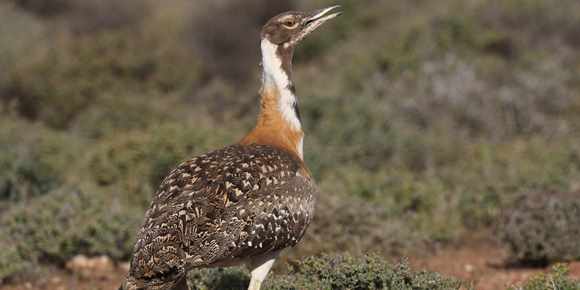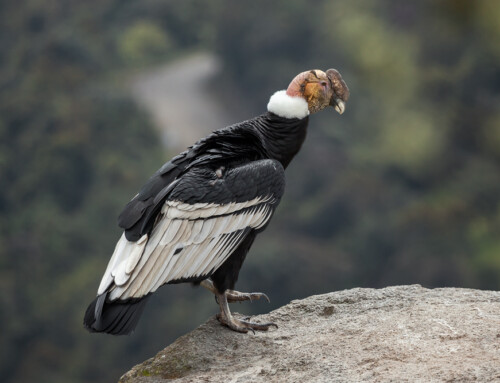What contributes to the unsustainably high rate of Ludwig’s Bustard power-line collisions?
LINKED PAPER
High power line collision mortality of threatened bustards at a regional scale in the Karoo, South Africa. Shaw, J.M., Reid, T.A., Schutgens, M., Jenkins, A.R. & Ryan, P.G. 2018. IBIS. DOI: 10.1111/ibi.12553. VIEW
Impacts of overhead lines on birds were noted almost as soon as they were introduced in the nineteenth century. Proliferation of these man-made structures in the landscape is relatively recent so birds are not evolved to avoid them, and power-line collisions today are a well-recognised conservation problem for many species. The size of the global electricity network is staggering, and it has been built largely without taking measures to safeguard wildlife. The power-line network continues to grow rapidly, particularly in developing countries.
While research has been ongoing for many years, it is usually difficult to understand the impacts of power-line mortality at a population level, because commonly conducted studies on short lengths of high-risk power line can’t be extrapolated to regional levels. Representative collision data, with sufficient spatial and temporal extent, must be collected and corrected for survey biases (e.g. removal of carcasses by scavengers, efficiency of searchers) to generate realistic overall collision rates. It is also difficult to gauge accurately the seriousness of the threat posed by collisions unless detailed data on population size, range, and demographic parameters of affected species are available.
A variety of technical, biological, landscape and meteorological factors affect the risk of a power-line collision, but these vary between areas and species. Understanding contributory factors is key to being able to predict and mitigate impacts. Much focus in the literature to date has been on high-voltage transmission power lines, but lower voltage distribution lines also kill birds, and given their far greater overall extent, distribution lines can represent a serious source of mortality.
Southern Africa has a rich community of large terrestrial birds, and is of particular importance for its unique diversity of bustards, with six of its 11 species endemic to the region. Unfortunately, the conservation status of these iconic open country birds is generally poor. We had particular concern for the relatively little known Ludwig’s Bustard, Neotis ludwigii, southern Africa’s third largest bustard species, following incidental collision reports and Andrew Jenkins’s preliminary mortality surveys. The morphology and behaviour of this species contribute to its susceptibility to collisions – it is large and relatively heavy bodied so lacks aerial manoeuvrability, often flies in low light, undertakes extensive seasonal migrations and nomadic movements, and has limited frontal vision. The remote Karoo is home to Ludwig’s Bustard; extensive livestock farming is the main land use in this vast, semi-arid, mostly flat and largely treeless region of western and central southern Africa.
To take account of the spatial and temporal variation inherent in collision rates of a mobile species in an unpredictable environment, we conducted comprehensive surveys throughout the core range of Ludwig’s Bustard in South Africa every three months. We surveyed high-voltage transmission lines by vehicle at five sites (total length 252 km) right across the Karoo region for two years (with each survey taking 2 weeks and thousands of kilometres of travel). Low-voltage distribution lines were surveyed on foot (95 km) for one year. We used the data generated to infer the factors affecting Ludwig’s Bustard collisions, and together with our previous work on survey biases, to generate regional estimates of collision rates on transmission and distribution power lines.

The results of our extensive surveys confirmed our fears; of the 679 carcasses recovered, Ludwig’s Bustards constituted 69% and other bustards a further 18% of collisions from 30 species found dead. Significant explanatory variables of Ludwig’s Bustard collisions were season (collisions were more likely in winter), rainfall (were less likely in drier areas) and year on transmission lines (highlighting variability between years). Season and proximity to roads were significant variables on distribution lines, with collisions more likely during winter and away from roads. It may be helpful therefore to run future distribution lines along roads.
Ludwig’s Bustard collision rates (corrected for survey biases) were higher on transmission (1.12; 95% confidence interval (CI) 0.40–2.58 bustards/km/year) than on distribution lines (0.86; 95% CI 0.30–1.96), but these smaller lines are four times as extensive in South Africa. Given that the latest South African population estimate is of 114,000 birds (95% CI 87,000-148,000), these rates are extremely high, and while there is no evidence of a population decline to date, it is difficult to understand how such mortality can be sustained. However, for a mobile species in a remote area, population and mortality estimates are highly variable, so it may be difficult to detect any decline until it is severe. Ludwig’s weren’t the only concern; despite being much less abundant, Kori Bustards, Ardeotis kori, were the second most commonly recovered species, with collision rates of 0.10 bustards/km/year (95% CI 0.05–0.19) on transmission lines in just one area of the Karoo.

With an increasing number of other studies from around the world highlighting the threat that overhead wires pose to bustards, our results add to growing concern about power-line impacts on bustards globally. To adequately conserve these birds, it will be vital to better understand the ecology of lesser known species, to focus efforts on the search for effective mitigation (there is little evidence to date that commonly used line markers are effective in reducing bustard collisions relative to other species) and to work with power utilities to minimise impacts as far as possible (e.g. by avoiding key areas and taking contributory collision risk factors into account when route planning).
References
Shaw, J.M., Reid, T.A., Schutgens, M., Jenkins, A.R. & Ryan, P.G. 2018. High power line collision mortality of threatened bustards at a regional scale in the Karoo, South Africa. IBIS 160: 431–446. VIEW
Image credit
Featured image: Ludwig’s Bustard, Neotis ludwigii © Peter Ryan
Author portrait © Rosa Gleave
Blog posts express the views of the individual author(s) and not those of the BOU.
If you want to write about your research in #theBOUblog, then please see here.





